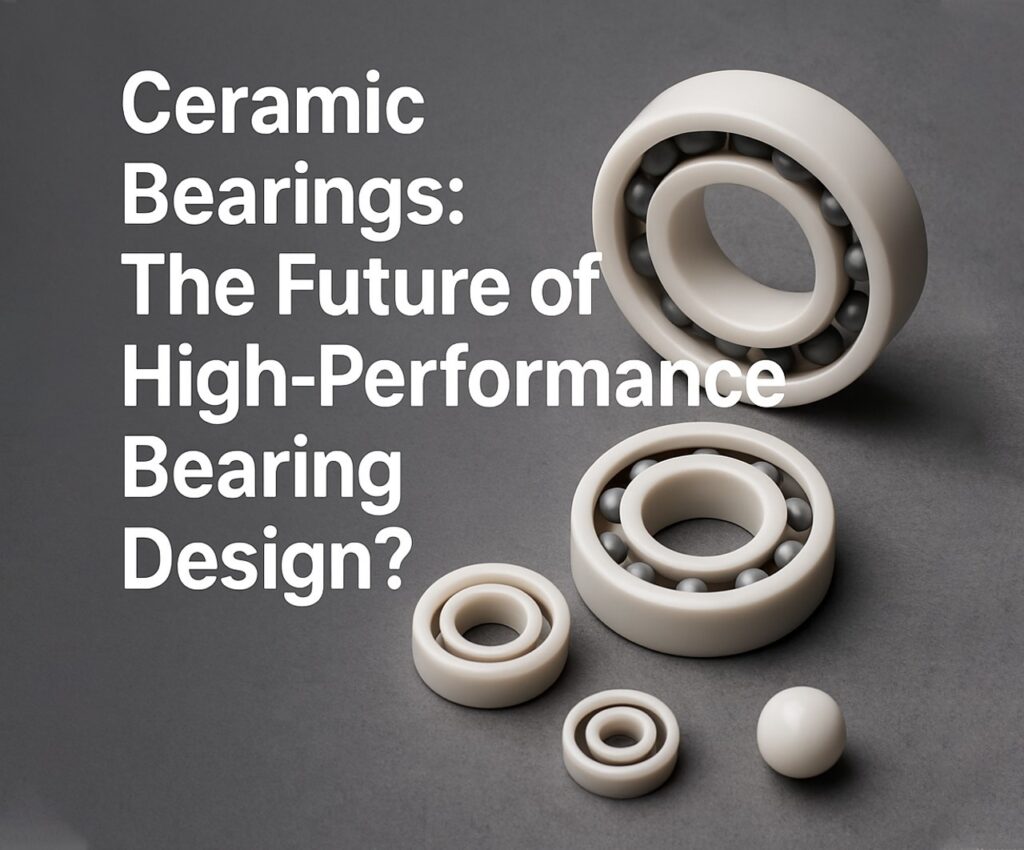In the race for speed, durability, and precision, ceramic bearings, ceramic ball bearings, and the advanced ceramic ball are quickly emerging as the gold standard in high-performance bearing design. From aerospace to cycling to semiconductor manufacturing, engineers are increasingly turning to ceramics to outperform traditional steel. But what makes ceramic bearings so special? And are they truly the future of motion control? Know More
What Are Ceramic Bearings?
Ceramic bearings are bearing assemblies that use ceramic materials for either the rolling elements, the races, or both. The most common form, ceramic ball bearings, features a steel or hybrid race with rolling elements made from a ceramic ball—typically silicon nitride (Si3N4), zirconia (ZrO2), or alumina (Al2O3).
These materials are chosen for their hardness, heat resistance, and corrosion resistance, making them ideal for demanding applications where steel bearings may degrade or fail.
Why Ceramic Bearings Outperform Steel
When comparing ceramic bearings to their steel counterparts, the advantages stack up fast:
- Lightweight: A ceramic ball is about 60% lighter than a steel ball, reducing centrifugal force and increasing rotational efficiency.
- Harder Surface: Ceramic surfaces are up to 30% harder than steel, leading to superior wear resistance.
- Low Friction: Ceramic ball bearings generate less heat and consume less energy due to reduced surface contact.
- Corrosion Resistance: Unlike steel, ceramics won’t rust—ideal for marine, chemical, or humid environments.
- High-Speed Capability: Lower friction and mass make ceramic bearings the go-to choice for ultra-fast rotation.
- Longer Life: With less wear and better heat resistance, ceramic-equipped systems often last significantly longer.
Types of Ceramic Bearings
- Full Ceramic Bearings
- Both races and balls are ceramic.
- Best for high-speed, low-load, or highly corrosive environments.
- Hybrid Ceramic Bearings
- Steel races with ceramic ball elements.
- Most common configuration, combining strength with ceramic advantages.
- Silicon Nitride Bearings
- Strong, thermally stable, and electrically insulating.
- Popular in electric motors and aerospace.
- Zirconia Bearings
- More impact-resistant, often used in medical and food-grade systems.
Creative and Emerging Applications
Ceramic bearings are reshaping expectations across industries:
1. Electric Vehicles (EVs)
Lightweight and energy-efficient ceramic ball bearings reduce energy loss in EV drivetrains and improve range.
2. Professional Cycling
From bottom brackets to wheel hubs, ceramic ball components help competitive cyclists shave off milliseconds and gain efficiency.
3. Aerospace
The extreme temperatures and forces experienced in jet engines and satellite systems require the thermal and mechanical resilience of ceramic bearings.
4. Semiconductor Manufacturing
Vacuum environments and precise movements demand ultra-clean, non-magnetic, and low-outgassing materials—a perfect case for full ceramic ball bearings.
5. Medical Devices
Implantable pumps and surgical tools benefit from biocompatible and low-friction ceramic components that require minimal maintenance.
The Science Behind the Ceramic Advantage
Ceramics such as silicon nitride boast remarkable properties:
- Hardness: 78 HRC compared to steel’s 60 HRC
- Thermal Conductivity: Lower than steel, reducing thermal expansion
- Modulus of Elasticity: Less deformation under load
- Density: Significantly lighter than steel
These characteristics mean that when a ceramic ball rolls, it doesn’t deform or heat up as quickly, which translates to greater precision and less wear over time.
Debunking Common Myths
- Ceramic bearings are too brittle
- High-quality ceramic ball bearings made from silicon nitride are incredibly tough, not fragile.
- Too expensive for most uses
- While the upfront cost is higher, longer lifespan and reduced maintenance often justify the investment.
- Only useful for niche applications
- More industries are adopting ceramic bearings as materials and manufacturing costs become more accessible.
Choosing the Right Ceramic Bearing
To get the most out of ceramic bearings, consider these variables:
- Load Type and Intensity: Full ceramic bearings are better for light loads; hybrids work well under moderate to high loads.
- Speed Requirements: High RPM systems benefit greatly from ceramic ball technology.
- Temperature Conditions: Ceramics resist thermal breakdown, making them ideal for extreme environments.
- Corrosive or Clean Conditions: Opt for zirconia or full ceramic for cleanrooms or corrosive atmospheres.
Smart Integration and Best Practices
To properly use ceramic bearings:
- Avoid Overloading: Even strong ceramics can fracture under improper load.
- Ensure Proper Fit: Misalignment or poor housing can negate all ceramic advantages.
- Use Matching Lubricants: Choose lubricants compatible with ceramic surfaces.
- Consider Vibration Sensitivity: In highly dynamic environments, hybrid bearings may offer a safer choice.
Real-World Case Study: High-Speed Dental Drills
A dental equipment manufacturer switched to ceramic ball bearings in its high-speed handpieces. The result?
- 40% reduction in bearing failure rate
- 15% faster operational speeds
- Less heat, leading to improved patient comfort
Thanks to the resilience of the ceramic ball, the drills now last longer between servicing, reducing costs for clinics and increasing uptime.
The Environmental Angle
Sustainability also favors ceramic bearings:
- Longer lifespan means fewer replacements and less waste
- Reduced lubrication minimizes environmental contamination
- Lower energy use due to decreased friction
Future Trends: Smarter, Smaller, Stronger
- Sensor-Embedded Bearings: Track heat, vibration, and wear in real-time.
- 3D-Printed Ceramic Components: Reduce prototyping time and cost.
- Nanocomposite Coatings: Further enhance ceramic ball performance.
- Industry Standardization: Expect wider adoption as costs decrease and standards improve.
Final Thoughts: Are Ceramic Bearings the Future?
With their unmatched strength-to-weight ratio, corrosion resistance, and energy efficiency, ceramic bearings, ceramic ball bearings, and the advanced ceramic ball are undeniably shaping the future of bearing design. As industries push the limits of speed, heat, and reliability, ceramics are not just a luxury—they are becoming a necessity.
Whether you’re designing a satellite, tuning a race bike, or optimizing an electric motor, integrating ceramic bearings can unlock new levels of performance. They’re not just the future; for many applications, they’re already the standard.

